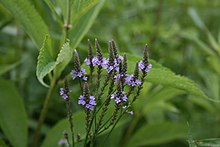| Verbena hastata | |
|---|---|

| |
| Conservation status | |
 Secure (NatureServe) | |
| Scientific classification | |
| Kingdom: | Plantae |
| Clade: | Tracheophytes |
| Clade: | Angiosperms |
| Clade: | Eudicots |
| Clade: | Asterids |
| Order: | Lamiales |
| Family: | Verbenaceae |
| Genus: | Verbena |
| Species: | V. hastata |
| Binomial name | |
| Verbena hastata L. | |
Verbena hastata, commonly known as American vervain, blue vervain, simpler's joy, or swamp verbena, is a perennial flowering plant in the vervain family Verbenaceae. It grows throughout the continental United States and in much of southern Canada.
Description
V. hastata grows as a stiffly erect stem, occasionally branching in the upper half, reaching up to 1.5 m (5 ft) tall. The stems are four-angled (square), hairy, and green to reddish in color. Leaves are opposite, simple, and measure up to 15 cm (6 in) long and 3 cm (1 in) across. They have doubly-serrate margins and a variety of shapes, from lanceolate to ovate, and may have 2 lateral lobes.

The inflorescence is a panicle, or group, of flowering spikes, up to 30 cm (1 ft) long at the end of the upper stems. Each flowering spike in the panicle is up to 13 cm (5 in) long, with densely packed, numerous 5-lobed flowers, which measure up to 1 cm (0.25 in) long. The flowers are violet or deep purple, rarely white. They open from the bottom of the spike upward, with only a ring of a few flowers open at a time.
Phytochemicals
Verbena hastata contains Lophirone C, Lophirone B, Verbenalin, Verbascoside, Luteolin, Oleanolic acid, Ursolic acid, and the naphthoquinone derivative 4,9-dihydroxy-α-lapachone.
Taxonomy
This species is a member of the diploid North American vervains which have 14 chromosomes altogether. Hybridization seems to have played some role in its evolution, presumably between some member of a group including the white vervain (V. urticifolia), V. lasiostachys or V. menthifolia, and V. orcuttiana or a related species.
In the recent evolutionary past, there has been an incident of chloroplast transfer of one of the latter or the swamp verbena to the mock vervain Glandularia bipinnatifida which is a close relative of the genus Verbena. It is unknown by what mechanism this happened, but it is suspected that hybridization is not responsible.
Etymology
The Latin specific epithet hastata means "spear-shaped".
Distribution and habitat
V. hastata is native in the United States in all states except Alaska and Hawaii. In Canada, it is native in the provinces of British Columbia, Saskatchewan, Manitoba, Ontario, Quebec, New Brunswick, Nova Scotia, and Prince Edward Island. The plant prefers moist conditions and typically grows in wet meadows, wet river bottomlands, stream banks, slough peripheries, fields and waste areas. It is adapted to wetlands and can spread to form small colonies.
Ecology
The flowers bloom from mid- to late summer.
It attracts bees and is a larval host to the common buckeye butterfly (Junonia coenia), the verbena moth (Crambodes talidiformis), and the verbena bud moth (Endothenia hebesana).
Footnotes
- BSBI List 2007 (xls). Botanical Society of Britain and Ireland. Archived from the original (xls) on 2015-06-26. Retrieved 2014-10-17.
- "NatureServe Explorer 2.0". explorer.natureserve.org.
- "Lady Bird Johnson Wildflower Center - The University of Texas at Austin". www.wildflower.org. Archived from the original on 2023-10-03. Retrieved 2024-07-29.
- ^ "USDA Plants Database". plants.usda.gov.
- ^ "Blue Vervain (Verbena hastata)". www.illinoiswildflowers.info.
- ^ Denison, Edgar (2017). Missouri Wildflowers (Sixth ed.). Conservation Commission of the State of Missouri. p. 103. ISBN 978-1-887247-59-7.
- ^ "Verbena hastata - Plant Finder". www.missouribotanicalgarden.org.
- Yokosuka, Akihito; Honda, Misaki; Kondo, Hitoshi; Mimaki, Yoshihiro (2021). "Chemical Constituents of the Whole Plant of Verbena hastata and Their Inhibitory Activity Against the Production of AGEs". Natural Product Communications. 16 (4): 1934578X2110097. doi:10.1177/1934578X211009727. S2CID 233472626. Archived from the original on 2023-04-02. Retrieved 2024-07-29.
- Yuan & Olmstead (2008)
- Harrison, Lorraine (2012). RHS Latin for Gardeners. United Kingdom: Mitchell Beazley. ISBN 978-1845337315.
- ^ Xerces Society (2016). 100 Plants to Feed the Bees. Storey Publishing. p. 41. ISBN 978-1-61212-886-3.
- The Xerces Society (2016), Gardening for Butterflies: How You Can Attract and Protect Beautiful, Beneficial Insects, Timber Press.
References
- Yuan, Yao-Wu & Olmstead, Richard G. (2008): A species-level phylogenetic study of the Verbena complex (Verbenaceae) indicates two independent intergeneric chloroplast transfers. Molecular Phylogenetics and Evolution 48(1): 23–33. doi:10.1016/j.ympev.2008.04.004
External links
- Verbena hastata in the CalPhotos photo database, University of California, Berkeley
- "Verbena hastata". Calflora. Berkeley, California: The Calflora Database.
- "Verbena hastata". Plants for a Future.
- Jepson Manual Treatment
- Washington Burke Museum
| Taxon identifiers | |
|---|---|
| Verbena hastata |
|
- NatureServe secure species
- Verbena
- Flora of Western Canada
- Plants described in 1753
- Taxa named by Carl Linnaeus
- Flora of Eastern Canada
- Flora of the Northeastern United States
- Flora of the Southeastern United States
- Flora of the North-Central United States
- Flora of the South-Central United States
- Flora of the Northwestern United States
- Flora of the Southwestern United States